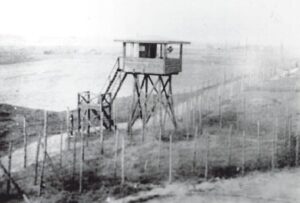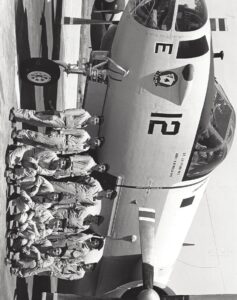I entered the Navy’s Preflight program two years ahead of author Mike Stock. Although, I am totally lacking in the heroic aviation experiences of the author, Mike Stock, described in his book Chasing the four Winds which tell of his Vietnam combat encounters and Test Pilot qualifications. There were, however, a few surprising coincidences. The following are examples:
Unlike many military pilots who dreamed of flying airplanes as youngsters, Stock and I had none of those aspirations but ended up in Navy flight training following casual comments by Navy recruiters on our college campuses. In Stock’s case it was, “Hey, do you have a few Minutes? Why not take the aptitude test to be a Navy pilot? What do you have to lose?” In my case it was, “Come over to Naval Air Station Glenview. See a Navy airplane. Check us out,” We both swallowed the hook and signed up. And we both responded well to the regimentation and discipline of military structure. Each of us ended up as one of four cadet officers to lead our 35-member Preflight class in their graduation ceremonies.

After basic training, Stock and I both endured the infamous SERE School ( Survival, Evasion, Resistance, Escape) conducted by the Navy. The POW phase of that experience with its waterboarding and brutality was as close to the real thing as the instructors could make it. Being forced into an enclosed box about half the size of a coffin, causing breaths to come in short gasps and legs to scream with cramping tested one’s claustrophobic resistance. Stock handled that experience somewhat better than I did.

Both Stock and I had collateral duties in or squadrons as safety officers. The major threat of that job was having to document an aircraft accident. The paperwork involved was like trying to write a PhD dissertation. Fortunately, both of us dodged that ordeal, although, I only missed it by days. A week after my separation from the Navy, one of our aircraft flew cross country to an Air Force base in Johnson City Texas. Unbeknown to the pilot, the plane had just come out of maintenance and the release mechanism to lower the wheels had not been installed. Arriving at the destination, nothing they tried could resolve the problem and a wheels-up landing on a foamed runway was the only alternative.
The pilot made an excellent crash landing, but one of the crew members jumped out of the after-station hatch before the plane came to a complete stop and broke his leg. As if that wasn’t enough, the Air Force dispatched a cherry picker to remove the plane from the runway and dropped the plane resulting in total airframe damage. Whoever took my place as Safety Officer is probably still there 60 year later filling out paperwork.
The author described an incident while flying a helicopter as part of an ASW (Anti-Submarine Warfare) squadron. He had been deployed to the Mediterranean and was participating in a NATO war games exercise. A U.S. submarine, playing the role of the enemy, was spotted on the surface by the author’s helicopter minutes before the exercise officially began. Hovering just out of sight, when the exercise began the sub dove and the helicopter pounced launching its practice torpedo scoring a make-believe Kill.
That reminded me of my deployment to Rota Spain in 1967. We had just taken off on a patrol searching for Soviet submarines. We were still climbing out over the Atlantic when our bow observer reported seeing the conning tower of a submarine just coming to the surface. I immediately leveled off and dove on the emerging submarine. Seeing our approach, the sub did a crash dive disappearing below the waves.
We dropped PDCs (Practice Depth Charges) which were small explosive devices not intended to cause damage, but just to make an explosive sound. Three PDCs across an underwater target was a NATO signal to surface and identify yourself. Of course, detected Soviet submarines rarely complied with that suggestion. In this instance, the sub resurfaced flying an American flag and identifying itself as a U.S. nuclear submarine.

When we returned after our fourteen-hour patrol, our commanding officer reported he had received a phone call from the nuclear submarine’s commander. The sub captain said, “Congratulations to your P2V pilot. We had just returned from a long patrol and surfaced for the first time in months. Boom, boom, boom. Welcome home.”
Another connection was author Mike Stock’s mention on page 158 of Walter Cronkite’s announcement on his TV broadcast that Vietnam was unwinnable, and we needed to negotiate a peace settlement. That rang a bell with me in an interesting way. Cronkite had been a firm supporter of Lyndon Johnson’s aggressive waging of the Vietnam War but Cronkite was having second thoughts about the conflict and went to Vietnam to see what was going on. What changed Cronkite’s mind?
My high school classmate, Jack Lawrence, became a CBS reporter and was maybe one of the first journalist to be embedded with a Marine Combat unit in Vietnam. Jack had done several documentaries for TV titled, Charlie Company. Jack was also a colleague of Cronkite, Charles Collingwood, Eric Sevareid, and other CBS newscasting celebrities.
When Cronkite went to Vietnam to do his evaluation, he looked up Jack Lawrence. Jack told him of the pathetic nature of the war and the needless killing of both friendly and enemy. Cronkite’s unwinnable broadcast caused Johnson to not seek reelection. Johnson said, “If I have lost Cronkite, I have lost the America people.”.
Therefore, it can be said Jack Lawrence had a lot to do with Johnson’s decision not to run for reelection and the presidency of Richard Nixon. Jack and I have maintained email communications and occasional in-person visits.
At one place in Stock’s book, he mentioned having flown 105 hours in one month. In 1967 while deployed to Rota, Spain, my flight crew flew 85 hours in one month. That exceeded allowable flight hours for P2V flight crews, and we were grounded for four weeks, missing participation in the Arab-Israeli Six Day War.

Stock’s association with the aviation department of Purdue University in Lafayette, IN and my residence in Lafayette also had some similarities. Stock was teaching aerodynamic ground school classes and also giving flight instruction.
I moved to Lafayette in 1971 to join a family business. I had not flown for four years since my discharge from the Navy and missed it. My GI Bill allowed me to enroll at the government’s expense in flight training. I already had my Pilot’s Single Engine/Multi-Engine, Instrument rating, so I enrolled in a Certified Flight Instructor (CFI) program. I had no I intention to actually teaching flight instruction, I just wanted the free flight time.
As part of the instruction, I was supposed to practice with a student pilot. Why not use my seven-year-old son, Eric. He loved it and was a dedicated student, doing his homework and studying flight manuals. Unfortunately, my company moved me to southern Indiana to open a new branch and my CFI training ended.
Some years later, Eric, as a grad school student, enrolled in a pilot training program at a local airport. His instuctor asked, “ Have you ever flown before” And Eric responded, “Yeah, my Dad took me up on some flights.”
The instructor said, “So why don’t you try making the take off?”
Eric pushed the throttles forward, held the plane on the centerline, trimmed for climb, and leveled off at the assigned altitude.
Astounded, the instructor asked, “So when did your dad take you flying,”?
“When I was seven years old.”
One last story; Mike Stock described his last flight before retirement in 2017, capping a flying career of nearly 18,000 flight hours. My last fixed-wing flight as a pilot (probably-I hesitate to say never again) occurred in 2019. I had become interested in flying gliders and in order to get my add-on glider pilot rating, I needed to be current in fixed wing powered aircraft. The would require a Biannual Flight Review (Flight test) by a flight instructor. I hadn’t flown a powered airplane in years, so I asked my oldest son, Eric, a pilot and member of an Indy flying club, to bring one of his planes to my home airport for a refresher flight,
When Eric arrived, I asked him to verbally go through a complete start up, pre-flight, take-off, and landing sequence. I then copied his example from the right seat. It all came back to me readily. Walking into the FBO office afterwards, I announced to the lady at the desk, “Fifty years ago, I gave this young man his first flying lesson. Today, he taught me.
Chasing the Four Winds by Mike Stock is a fascinating book and I recommend it.
Jim, as always, interesting experiences. I like the fact that Eric became the teacher.
Great stories. Did your son pass you?
Wow!! Love reading this, and perhaps I’ll have to grab a copy of Four Winds myself.
I always enjoy reading about your (and our!) flying adventures!!